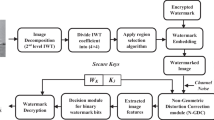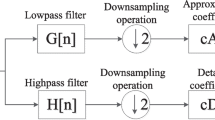Abstract
Reversible data hiding technologies have been considered largely impractical because those are, in most cases, applicable to raw video data rather than prevailing compressed data. Even though, many algorithms have been recently developed in the compressed video domain, most of them cannot guarantee the reversibility of cover video due to the lossy characteristics of video compression standards. We suggest completely practical data hiding scheme for H.264 baseline bitstream by achieving genuine reversibility for both I and P frames. Regardless of the data hiding algorithm, the proposed scheme can increase embedding payload by 66.9% and reduce computational complexity by 93%. Also, a novel compensation based difference expansion method with clever coefficient pairing strategy is proposed as a data hiding algorithm and achieved superior embedding payload vs. image quality performance. The proposed algorithm improves payload by 48.9% on average at almost the same video quality distortion.









Similar content being viewed by others
References
Alattar AM (2004) Reversible watermark using the difference expansion of a generalized integer transform. IEEE Trans Image Process 13(8):1147–1156
Bouchama S, Aliane H, Hamami L (2013) Reversible data hiding scheme for the H. 264/AVC codec 2013 IEEE international conference on information science and applications (ICISA) , pp 1–4
Chang CC, Lin CC, Tseng CS, Tai WL (2007) Reversible hiding in DCT-based compressed images. Inf Sci 177(13):2768–2786
Chen YH, Huang HC, Lin CC (2016) Block-based reversible data hiding with multi-round estimation and difference alteration. Multimed Tool Appl 75 (21):13679–13704
Chung KL, Huang YH, Chang PC, Liao HYM (2010) Reversible data hiding-based approach for intra-frame error concealment in h. 264/AVC. IEEE Trans Circuits Syst Video Technol 20(11):1643–1647
Fridrich J, Goljan M, Chen Q, Pathak V (2004) Lossless data embedding with file size preservation Electronic imaging 2004 international society for optics and photonics, pp 354–365
Gujjunoori S, Amberker BB (2012) A DCT based reversible data embedding scheme for MPEG-4 video using HVS characteristics ACM proceedings of the 8th Indian conference on computer vision, graphics and image processing, p 74
Hong W, Chen TS, Shiu CW (2009) Reversible data hiding for high quality images using modification of prediction errors. J Syst Softw 82(11):1833–1842
Hu Y, Lee HK, Li J (2009) DE-Based reversible data hiding with improved overflow location map. IEEE Trans Circuits Syst Video Technol 19(2):250–260
Huang HC, Lu YY, Lin J (2016) Ownership protection for progressive image transmission with reversible data hiding and visual secret sharing. Optik-Int J Light Electron Opt 127(15):5950–5960
Hsu CT, Wu JL (1999) Hidden digital watermarks in images. IEEE Trans Image Process 8(1):58–68
Jung SW, Ko SJ (2011) A new histogram modification based reversible data hiding algorithm considering the human visual system. IEEE Signal Process Lett 18 (2):95–98
Kang SU, Hwang HJ, Kim HJ (2012) Reversible watermark using an accurate predictor and sorter based on payload balancing. ETRI J 34(3):410–420
Li R, Wang R (2013) Video error resilience scheme using reversible data hiding technique for intra-frame in H. 264/AVC 3rd international conference on multimedia technology Atlantis Press (ICMT-13)
Liu H, Shao F, Huang J (2006) A MPEG-2 video watermarking algorithm with compensation in bit stream Digital rights management. Technologies, Issues, Challenges and Systems, Springer Berlin Heidelberg, pp 123–134
Liu Y, Ju L, Hu M, Ma X, Zhao H (2015) A robust reversible data hiding scheme for h. 264 without distortion drift. Neurocomputing 151:1053–1062
Lu C-S, Chen J-R, Fan K-C (2005) Real-time frame-dependent video watermarking in VLC domain. Signal Process Image Commun 20:624–642
Ma X, Li Z, Tu H, Zhang B (2010) A data hiding algorithm for h. 264/AVC video streams without intra-frame distortion drift. IEEE Trans Circuits Syst Video Technol 20(10):1320–1330
Mitchell J (1992) Digital compression and coding of continuous-tone still images: Requirements and guidelines. ITU-T Recommendation T, 81
Mobasseri BG, Berger IIRJ, Marcinak MP, NaikRaikar YJ (2010) Data embedding in JPEG bitstream by code mapping. IEEE Trans Image Process 19 (4):958–966
Mstafa RJ, Elleithy KM (2016) Compressed and raw video steganography techniques: a comprehensive survey and analysis. Multimedia Tools and Applications, pp 1–38
Muhammad K, Ahmad J, Rehman NU, Jan Z, Sajjad M (2016) CISSKA-LSB: Color image steganography using stego key-directed adaptive LSB substitution method. Multimedia Tools and Applications, pp 1–30
Ni Z, Shi YQ, Ansari N, Su W (2006) Reversible data hiding. IEEE Trans Circuits Syst Video Technol 16(3):354–362
Qian Z, Zhang X (2012) Lossless data hiding in JPEG bitstream. J Syst Softw 85(2):309–313
Qu X, Kim S, Kim HJ (2015) Reversible watermarking based on compensation. J Electr Eng Technol 10(1):422–428
Sachnev V, Kim HJ, Nam J, Suresh S, Shi YQ (2009) Reversible watermarking algorithm using sorting and prediction. IEEE Trans Circuits Syst Video Technol 19(7):989–999
Shahid Z, Puech W (2013) A histogram shifting based RDH scheme for H. 264/AVC with controllable drift IS&T/SPIE electronic imaging international society for optics and photonics, pp 86650S–86650S
Team JV (2003) Advanced video coding for generic audiovisual services. ITU-t Rec H 264:14496–10
Tian J (2003) Reversible data embedding using a difference expansion. IEEE Trans Circuits Syst Video Techn 13(8):890–896
Tourapis AM, Leontaris A, Suhring K, Sullivan G (2009) H.264/14496-10 AVC reference software manual. Doc. JVT-AE010
Tsai YY, Tsai DS, Liu CL (2013) Reversible data hiding scheme based on neighboring pixel differences. Digital Signal Process 23(3):919–927
Wang K, Lu ZM, Hu YJ (2013) A high capacity lossless data hiding scheme for JPEG images. J Syst Softw 86(7):1965–1975
Xu D, Wang R, Shi YQ (2014) An improved reversible data hiding-based approach for intra-frame error concealment in h. 264/AVC. J Vis Commun Image Represent 25(2):410–422
Xuan G, Shi YQ, Ni Z, Chai P, Cui X, Tong X (2007) Reversible data hiding for JPEG images based on histogram pairs International conference image analysis and recognition. Springer Berlin Heidelberg, pp 715–727
Acknowledgments
This research was supported by Basic Science Research Program through the National Research Foundation(NRF) of Korea funded by the Ministry of Science, ICT & Future Planning (NRF-2015R1C1A1A02037777).
Author information
Authors and Affiliations
Corresponding author
Rights and permissions
About this article
Cite this article
Kim, H., Kang, Su. Genuine reversible data hiding technology using compensation for H.264 bitstreams. Multimed Tools Appl 77, 8043–8060 (2018). https://doi.org/10.1007/s11042-017-4698-6
Received:
Revised:
Accepted:
Published:
Issue Date:
DOI: https://doi.org/10.1007/s11042-017-4698-6




